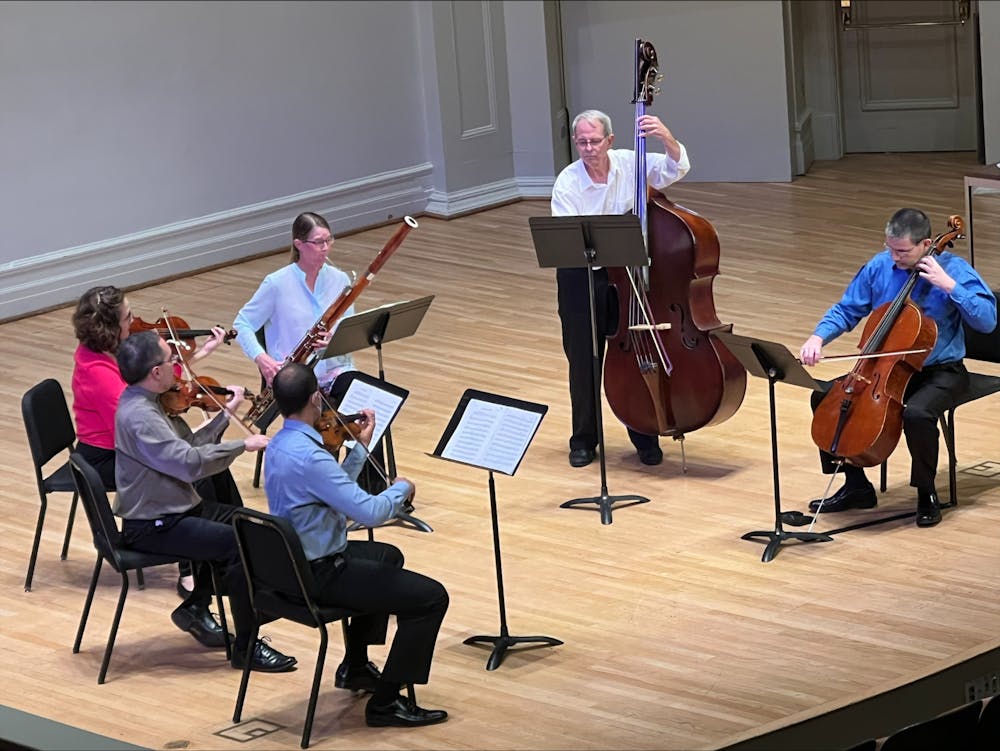On a brisk Sunday afternoon, an audience of local classical music enthusiasts and aspiring student musicians alike situated themselves in Old Cabell Hall, preparing for the first concert of the 2023-24 season. Three different ensemble groups made up the roster of the concert — a string quintet with accompanying solo bassoonist Elizabeth Roberts, a trio composed of Bb clarinet, horn and trombone and a percussion viola duet, representing centuries of musical style and technique.
As the lights dimmed and the faint hum of tuning strings filtered out from the wings, focus was drawn center stage towards empty seats soon to be filled and a weighty silence soon to be relinquished.
The audience was immediately met with the stoic musical persona of the father figure from the first piece, “Portrait of a Family.” A steady pulse provided by the lower string register, with Adam Carter on cello and Peter Spaar on contrabass, as the bassoonist navigated the alto range with a decisive zeal.
This grounded state was soon cast away, as the hall was consumed with the soulful swirlings of “The Mother,” somber but with a searching almost yearning melodic drive. This was cut short, however, by the pedantic thumping of “The Firstborn Son,” underscored by a similar militant confidence as “The Father” but with more boastful glee.
Closing out the piece were the two free-spirited younger siblings, “The Dancing Daughter” and “The Baby Brother,” both rife with unchecked youthfulness. The daughter sauntered in with her dancelike swells, reveling in the spontaneity of her ¾ waltz feel while her counterpart, “The Baby Brother,” propelled himself with less sure momentum, fast and bouncy as the performers dug in to keep pace with the flurry of pizzicato falls.
The ability of the musicians to fully embody the caricature of the family unit was truly impressive, with each movement propelling the audience into contemplation of their own family role. Each movement seemed to resonate with different members of the audience, depending on which role they have themselves embodied.
As the audience recovered from the reflective aftertaste of the first piece they were welcomed back into serenity by Václav Nelhybel’s “Trio for Brass”, edited by Jiyeon Choi. This trio featured Jiyeon Choi on Bb clarinet, Cody Halquist on horn and Nathaniel Lee on tenor trombone — an unusual pairing — with the horn serving as a melodic bridge of sorts between the woody wholesome tamer of the clarinet with the brash lower register of the trombone, making for a delightful listen.
The whole piece read as a study into the dynamics of this unusual pairing, flirtatious and bouncy in its exploration of both motion and meter. While it was overall a melodically simple piece, it filled the chamber with a myriad of motifs — demanding a fervent trombone, somber clarinet and horn and a warm heroic tonal passage to conclude.
As the audience returned from intermission, discussion began as to why the percussionist was meticulously laying out mixing bowls along with three spindly wooden mallets with cotton pads taped on, a set of hair combs and a wooden slab placed center stage.
Now the stand-out piece — based on the audience's laughter and engagement — “Duet for Concert bowls and Kitchen Viola” by Class of 2021 alumnus Cameron Church. Church’s piece incorporated the tonal range of seven different kitchen mixing bowls, performed by I-Jen Fang, along with a “kitchen viola”, performed by Ayn Balija, that, to the audience's bewilderment, was tuned completely out of the western octave and was instead specially tuned to the new tonal structure of the mixing bowls.
Beginning the piece with an audience of hitched breaths, the percussionist and violist locked eyes, both holding bows as they ran them across their instruments, calling forth a haunting harmony. A sound only akin to the ringing of an ear filled the hall, as both instrumentalists took turns lurching out unheard-of tones.
Both musicians continued experimenting with their newfound musical freedom — clawing, scraping, hitting and combing out new melodies from the mundane. As the cacophony built — borderline melodic at times — it seemed always to dissolve back into just bowls.
In a flurry of concluding creative exercising, the percussionist began to slam the bowls into one another, creating new harmonies with their internal resonance. With all seven bowls in hand, the percussionist promptly spiked the bowls onto the centered wooden slat. With a smirked grin, they fled to the wings as the audience rose to their feet in unadulterated applause.
After the resounding response from the audience, the full ensemble returned to center stage to receive their applause. Each group performed wildly different pieces yet they were all like in their ability to pull genuine emotions from the crowd with just a bow or reed.







